Beginner's Guide to Butterflies
Last updated 20th August, 2020
Would you like to learn more about butterflies?
Our guide covers what a butterfly is, the different types of butterflies and why butterflies are important. If you are an entomology enthusiast or are simply curious about butterflies, this guide will expand your knowledge, provide plenty of interesting and helpful facts and help you gain a new perspective on butterflies.

Table of Contents
What Is a Butterfly?

In this section, we will discuss the various attributes of butterflies, such as how many legs they have and their number of wings.
These magnificent flying insects have six jointed legs, compound eyes, a pair of antennae and four large scaly wings (which are often colourful and diverse). They have two hindwings and two forewings which are attached to their second and third thoracic segments. When in flight, a butterfly's wings move up and down, creating a figure-eight pattern. They also have three body parts and an exoskeleton.
Butterflies are part of the Lepidoptera order - a group of insects which includes butterflies and a variety of a moth species. They live and breed in a wide range of habitats such as sand dunes, lowland forest, wetlands, mountainous areas, grasslands, mangroves and salt marshes. A habitat is best suited to butterflies if it contains plenty of rocks surfaces and bare ground. In the UK, you can generally find them in grasslands (including back gardens).
There are four primary stages of a butterfly life cycle. First, a female will lay eggs on appropriate plants which will hatch a caterpillar in just four to six days. Several weeks later, the caterpillar will undergo chrysalis, the third stage of the life cycle of a butterfly. This is the caterpillar to butterfly stage. Toward the end of their life, an adult female will lay eggs, and the cycle starts over. It is considered that there are about 60 British butterflies in total by species.
Types of Butterflies
There are many butterfly types present across the UK. In the following subsections, we will explore details of some of these - including what they look like and what plants they feed on. This section will also help to improve your ability for butterfly identification.
For further help distinguishing one butterfly species from the rest, you can view British butterflies identification charts online
Peacock Butterfly
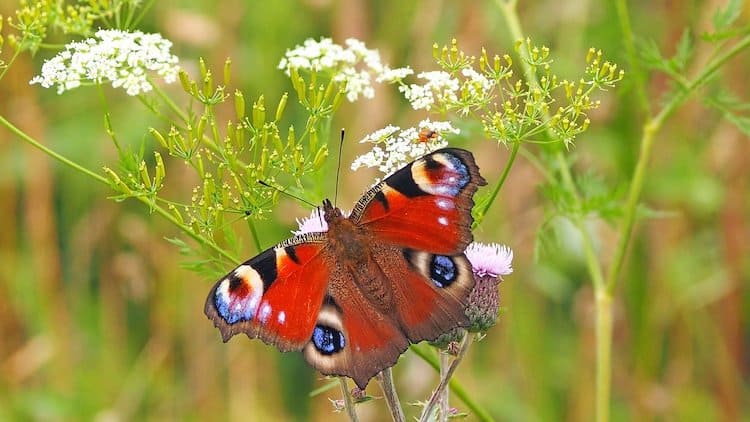
These butterflies have brownish-red wings, each of which has a large eyespot resembling a peacock feather (hence where their name comes from). This eyespot, which is designed to scare off predators, is one of their most identifiable features. When at rest, its wings close, displaying a well-camouflaged (near black) underside. Peacock caterpillars are black and spiny.
As one of the most common British butterflies, they are mostly found in the lowlands of Wales and England (but less common in Scotland). Adults tend to appear on sunny days, usually from March to Mary, and between July and September.
Adult peacock butterflies gain nourishment from flower nectar as taken from plants like buddleias bluebells (one of their favourite), dandelions, teas, betonies and thistles. Caterpillars of this species enjoy stinging nettles and hop.
Painted Lady Butterfly
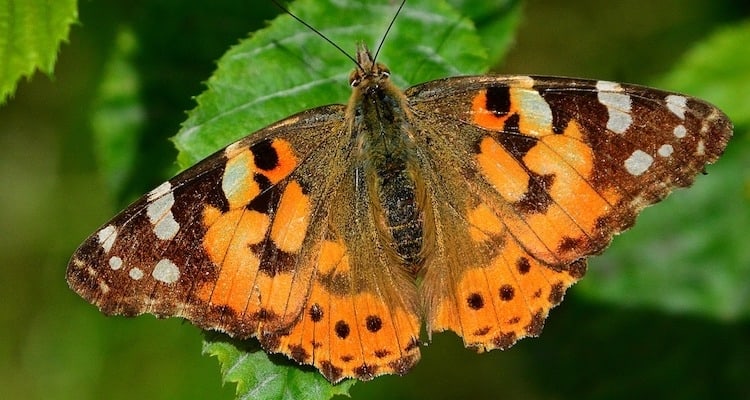
This type of butterfly has a pale buffy-orange backdrop to its upper wings while the forewings have black tips marked with white spots (one of their more distinguishable features). Several black spots are present on their hindwings while their undersides have blue eyespots against a pale background. These spots are relatively small. The spiny caterpillars of this species are black with tiny white spots and a yellow stripe along each side.
Painted ladies migrate to and from North Africa each year. They often arrive in the UK around early spring - but are most commonly found between May and June. After females lay small, green eggs on plants like thistles, nettles and mallows, caterpillars metamorphose into adults during the autumn before the bulk of painted ladies return to Africa for the winter.
When in Britain, they often live in habitats like meadows, hedges and nettle patches. Adults consume the nectar of various plants. The caterpillars eat the underside of the plant leaves of which their eggs were laid in. These often include thistles, nettles and mallows.
Red Admiral Butterfly
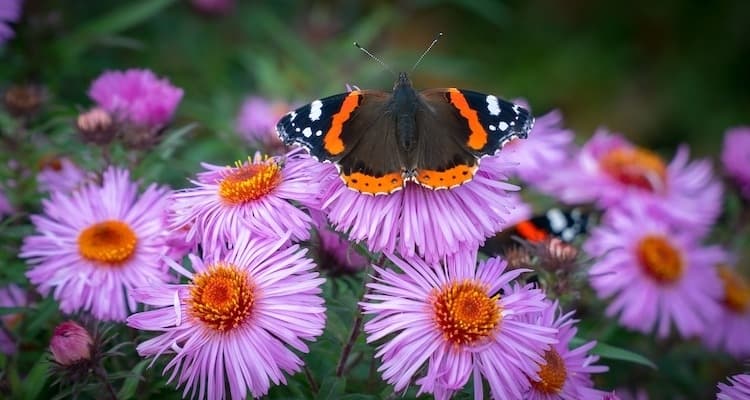
The wings of red admirals have a black-brown background, decorated with an orange-red stripe on either one. The edge of each forewing is black with white spots while their hindwings have a dark brown tone for camouflage. Their underside is orange, blue and white. Its unique mixture of black, white and red make these butterflies easy to identify. Red admiral caterpillars (which often hatch from eggs on the growing tips on nettles) have a dark colour overall with a pale yellow stripe on either side.
Following hibernation, adults fly northwards, often arriving from the continent during the summer months before returning south around mid-August. As a result, they tend to accumulate in larger numbers in southern England during the autumn while being more widespread across Britain for the months prior. Meadows, hedges and nettle patches are among their favourite habitats.
While many red admirals migrate to mainland Europe to hibernate, some will remain in England, often choosing exposed sites like a tree trunk to overwinter. However, many do not survive the British winter. Adults drink nectar from flowers like buddleia and often consume rotting fruit during the autumn months.
Monarch Butterfly
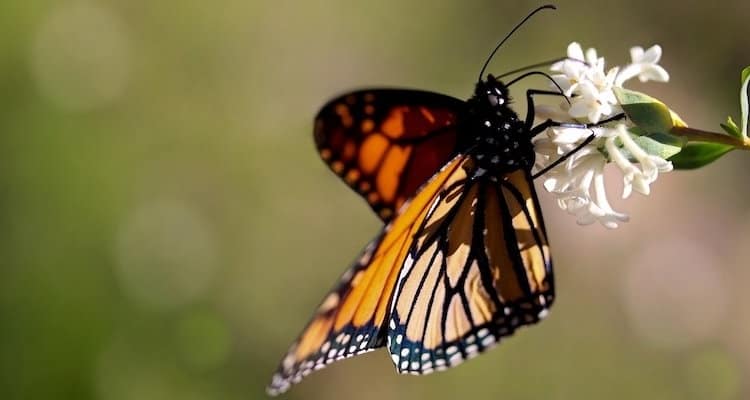
Monarchs are the largest butterflies found in the UK. They have a wingspan range of 95-100mm. They have a reddish-orange appearance with veiny black lines extending downwards along their wings. Along the edges of each wing are white dots on a black background covering its border. Their size and stained-glass, window-like appearance makes them easy to spot. Monarch caterpillars are lined with yellowish-green, white and black stripes of colour along their exterior.
While they are native to the United States, they are a rare migrant to the UK. They are more heavily concentrated in the south-west, in places like the Scilly Isles and Cornwall. With that said, they can be found in gardens, farmland and even on roadsides throughout the UK and generally hibernate in sheltered forests.
Adult monarchs feed on the nectar of plants such as zinnia flowers and ava flowers. Monarchs do not breed in the UK since their caterpillars feed on a range of Milkweeds which are not native to the British Isles.
Meadow Brown Butterfly
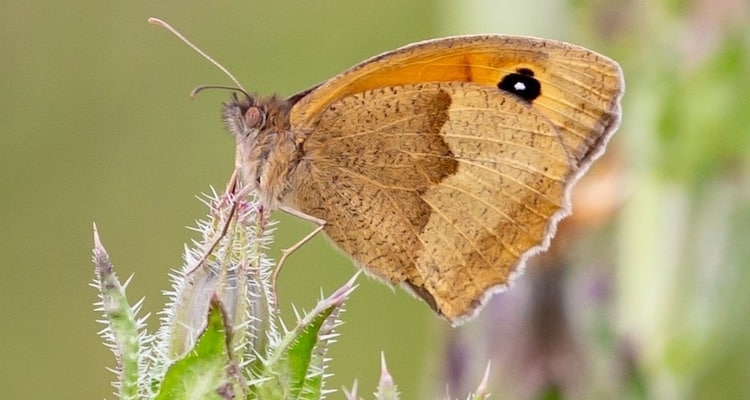
These butterflies are abundant and widespread across the UK, and it's estimated that meadow browns are the most common UK butterflies. With their pale brown backdrop, they can be identified thanks to having an eyespot on each forewing while having none on their hindwings.
They are most common in southern England, the Midlands and parts of Wales. Among their most used habitats are hay meadows, down land, heathland, coastal dunes, hedgerows and woodlands. Adults are often spotted flying low over flowers and grass in large numbers.
While the adults feed on the nectar of a variety of plants, Meadow brown caterpillars usually eat grasses like fine-leaved meadow grasses and fescue bents. They also sometimes feed on downy oat-grass and false brome.
Small White Butterfly
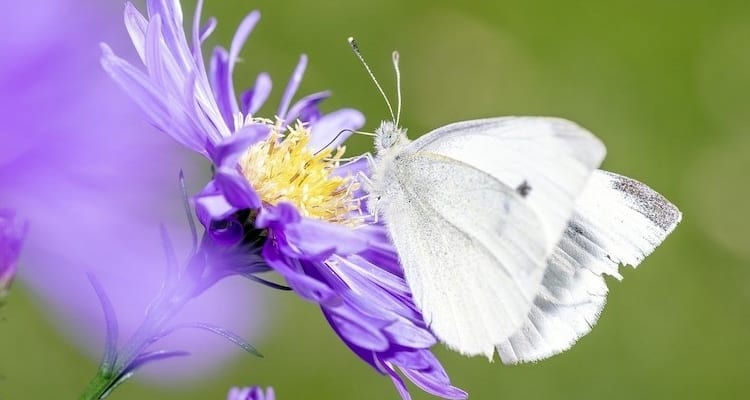
They are one of the most populous butterfly species present in the UK. Its striking white wings and distinctive black wing tips will help you to identify a small white butterfly. Also known as a cabbage white butterfly, this type of butterfly is a small to medium species with white or yellow wings. It also has small black tips on its forewings and either one or two wing spots, with creamy white undersides.
They are found throughout the UK but are scarcer in northern Scotland. The adults primarily feed on thistles, while small white caterpillars tend to consume brassica leaves. These caterpillars have a light green look.
Common Blue Butterfly
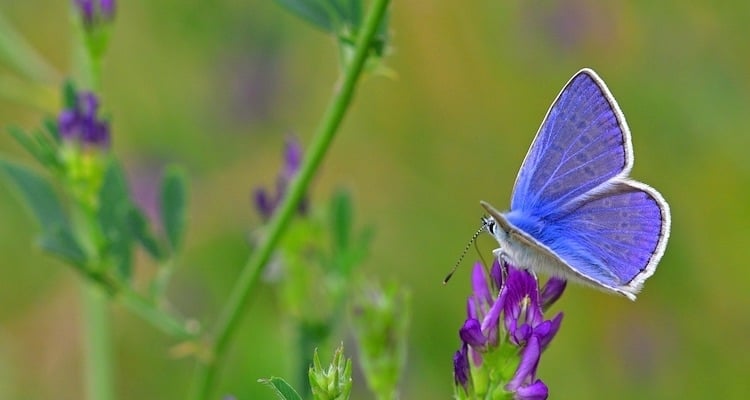
The exact appearance of common blue butterflies varies by gender. Males tend to have a violet-blue surface with a grey-beige underside while females can vary from those with largely brown upper wings along orange crescents to those with a bluer appearance.
Adults can usually be found from May to September and as late as October during warmer years. They feed on a range of flat-headed flowers while the caterpillars which are short, furry and green. They usually consume leguminous plants like white clovers.
Quite interestingly, a nutrient-rich secretion of these caterpillars attracts ants. In turn, the ants can by default protect the caterpillar from predators by deterring other insects from coming too close.
Small Tortoiseshell Butterfly
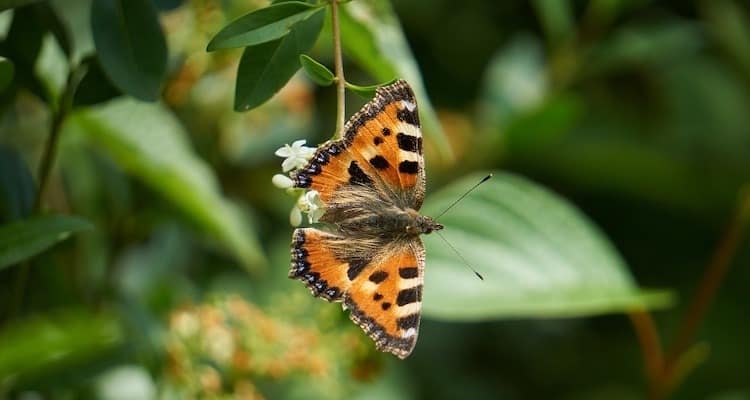
These colourful butterflies are bright orange with black and white tones along the upper edge of each forewing. Their hindwings have black layers along the lower border with blue crescents. It is this unique combination of orange, black, white and blue that makes the smart tortoiseshell relatively easy to spot. They also have a dark grey and brown underside.
Smart tortoiseshells are usually found between March and October. The adults feed on a variety of flowers and can be found in many flowery locations (including gardens) throughout both rural and urban areas across the UK. The caterpillars are black with a discontinuous yellow line on either side. They primarily feed off stinging nettles.
Ringlet Butterfly
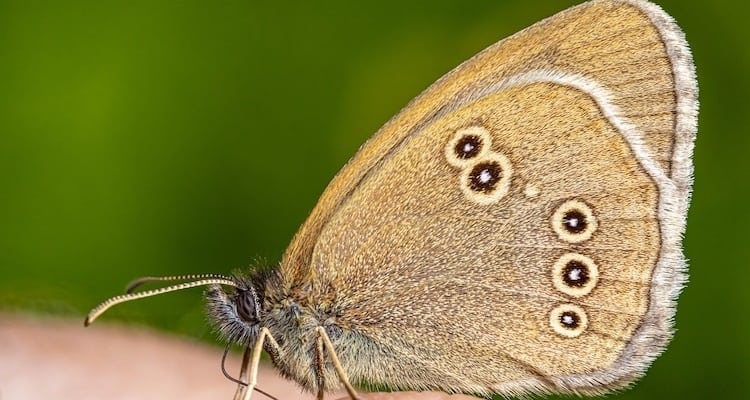
This type of butterfly has rings on its hindwings, from which its name comes from. The top side of the butterfly is a uniform brown which helps distinguish it from the Meadow Brown (a closely related species). Velvety wings are another identifiable trait of ringlet butterflies. Its dark colours mean that it can heat itself up faster than most butterflies. Notably, it is one of the few species which flies on overcast days.
Ringlet butterflies are present in most parts of the UK although they are not found in northern England, north Scotland or the north-west Midlands. You won't find them on the Channel Islands or the Isle of Man either.
Ringlet butterflies form unique colonies which can feature just a few dozen individuals to as many as several thousand. The adults tend to feed on the nectar of wild privet and bramble flowers. The caterpillars, which are light reddish-brown or grey with dark, red spots feed on grasses like a false broom and cock's foot.
Comma Butterfly
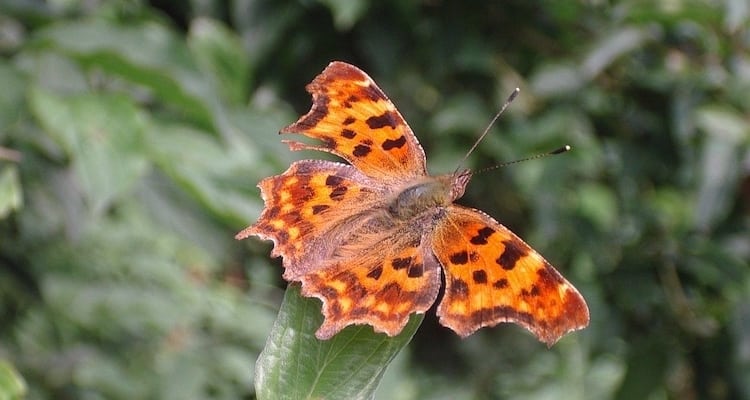
This orange-brown butterfly has darker markings. It has a strange wing shape which features irregular edges and striking white comma shape on its underwings which makes it easy to identify. The cryptic colours of the wings obscure adults when hibernating amid dead leaves.
Comma butterflies are widespread across England and Wales - but rare elsewhere in the UK. Their primary habitats are wood edges and open woodland. The adults feed on wildflower nectar while the caterpillars usually consume hops and common nettles. They may also consume elms, currants and willows.
Common Brimstone Butterfly
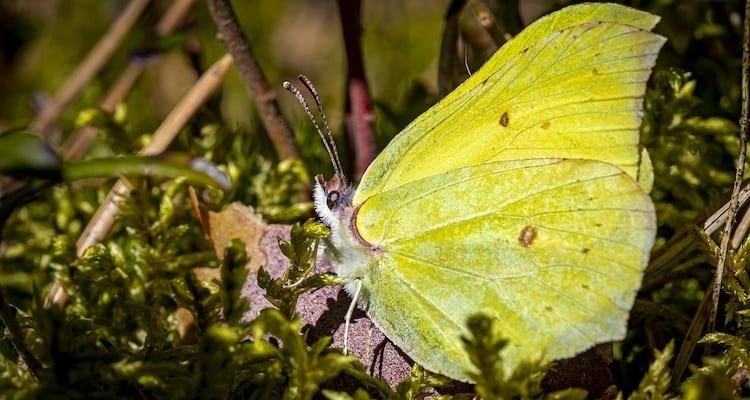
While not as common as most of the butterflies mentioned so far, common brimstones are still reasonably numerous across the UK. The male is yellow while the female has a pale yellow appearance with a greenish tinge. In either case, there will be an orange spot on both of their wings, which is one of their most distinguishable traits. The undersides of its wings are pale yellowish-green allowing it to easily camouflage among plant life if necessary.
They are most prevalent across England and Wales and tend to inhabit woodlands or gardens, especially earlier in the year when other butterfly species have yet to emerge. As an early riser, these common butterflies often hibernate earlier than others too (sometimes as soon as August).
For the adults, perhaps one of their favourite foods is the nectar of thistles. Common brimstone caterpillars which are medium green with speckles of dark green along their body often consume the leaves of buckthorn.
Why are Butterflies Important?
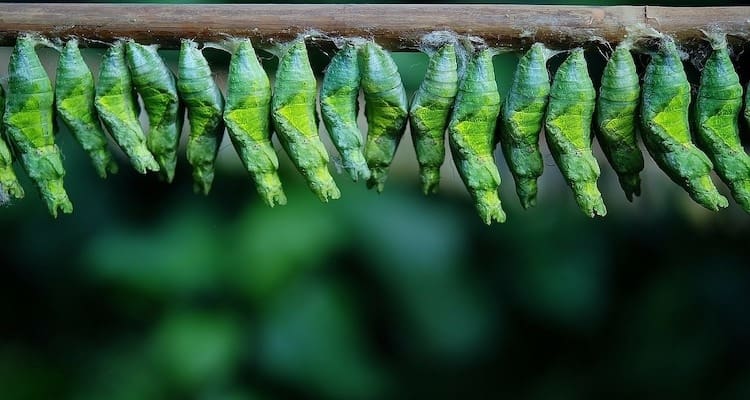
Butterflies benefit the natural world, our scientific knowledge and society in a variety of different ways. They support the ecosystem, add to our understanding of the natural world and are a beautiful natural addition to gardens.
But you may have a range of questions regarding the value of butterflies such as 'Are butterflies pollinators?' Let's discuss that.
Ecosystem
One of the primary benefits of butterflies is that they are an indicator of a healthy ecosystem and environment. Areas which are heavily populated with moths and butterflies are rich in other invertebrates. This, in turn, means higher levels of natural pest control and pollination throughout any given area.
Butterflies and moths act as an important part of the food chain too - since they are prey for bats, birds and other types of insectivorous animals. It is estimated that Blue Tits consume around 50 million moth caterpillars a year in Britain and Ireland alone.
Climate Change
The ability of butterflies to migrate and adapt effectively to a changing climate means that for the most part, they can continue to support ecosystems and food chains even as the planet warms. This has been largely true so far, but whether this trend will last as the temperature rises have yet to be seen.
Science
Another point of butterfly significance is how they have added to our treasure trove of scientific knowledge regarding the natural world.
Entomologists have been studying butterflies in detail for centuries. The scientific study of butterflies is known as lepidopterology. This also covers the research of moths. Butterflies are considered a vital group of model organisms for investigating a whole host of areas of biological study. Lepidopterology has allowed scientists to improve their understanding of fields like pest control, mimicry, evolution, genetics, population dynamics, biodiversity conservation, navigation and embryology.
Aesthetics
While a more trivial reason, there is no doubting that our world is a richer, more beautiful place with butterflies in it.
Societies and cultures the world over admire butterflies, and in ancient times some civilisations even perceived them as entities sent from the gods. Their unique patterns and large colourful wings have made them a fixation of humanity for millennia. Butterflies continue to be appreciated for their beauty today and more people are concerned with preserving them (and all species) from environmental degradation.
How to Encourage Butterflies in Your Garden
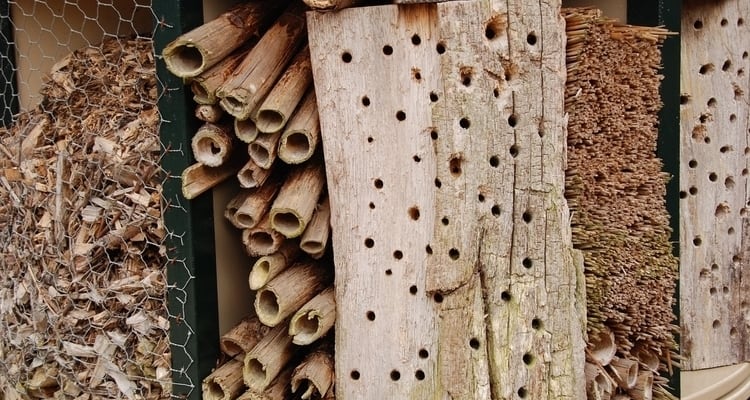
Whether it is to improve the biodiversity of your garden, to increase flower pollination or to simply enjoy the beauty of butterflies, there are many steps you can take to increase the likelihood of butterflies appearing in your garden.
Plants That Attract Butterflies
Certain plants can appeal to butterflies as a source of nectar to feed on. As shown in the 'types of butterflies' section, different species feed on different plants. To attract butterflies to your garden, in general, it is best to grow bright flowers. Buddleia, red valerian, verbena, hebe, lavender, sedum, common knapweed, perennial wallflower and wild marjoram are examples of flowers that can attract butterflies. Of course, plants like stinging nettles can also appeal to butterflies too as plants to lay their eggs on.
Leave Fallen Fruit on the Ground
During the early autumn, some butterflies prefer to feed on the sugar within discarded fruit. Some of the most common fruits that butterflies consume are apples, pears and berries. Sprinkling bits of fruit across your garden surface can help to attract butterflies. Butterflies find it difficult to consume any fruit that is too hard, so if you're leaving fruit atop a compost heat, it's preferable that it be as ripe as possible.
Create Warmth
Butterflies love the warmth, so it is best to grow nectar plants in sunny, sheltered areas. By planting a range of different plants, you can attract a greater variety of butterfly species. You should plant the same types of flowers in given blocks. Make sure that you provide the right flowers through the entire butterfly season.
Don't Weed
You won't attract butterflies without having the right conditions for caterpillars. You can support the growth of caterpillars by letting your garden grow around its edges. Thistles, nettles, ragwort, holly, ivy and mixed grasses are examples of popular food sources among caterpillars. By allowing even some of the less appealing wildflowers to grow, you can increase the chances of large swathes of butterflies arriving and staying in your garden. Allowing the grass to grow tall in one part of your garden during the summer can play its part in this process also.
Stop Using Pesticides
Pesticides are dangerous for butterflies and other pollinating invertebrates. As a result, its use will make it less likely for butterflies to accumulate in your garden. At the very least, you should stop using them around your flowering plants, if not entirely, throughout the garden. You should also be conscious of plants taken from the central area of the garden, which may have been treated with a pesticide previously.
Build a Butterfly House
These mini constructions can attract butterflies to your garden by acting as an appropriate and alluring habitat.
It should be placed in a sunny but sheltered area in the garden - so while it will offer warmth, which butterflies love, it will also be protected from windy weather. Ideally, it should stand approximately four to six feet tall and be located close to nectar-rich plants.
Additional steps you can take include decorating the butterfly house with bright coloured flowers using non-toxic paint. Alternatively, you may wish to add a bark layer to its front in order to give it an appearance similar to a tree. Placing a sugar solution inside this miniature insect dwelling can also be used to encourage butterflies in.
Here are the steps required to build a butterfly house:
- Use a measuring tape to draw out the elements of the butterfly house onto pieces of wood. Cut them out with a saw before smoothing down the edges with sandpaper.
- Next, connect the back panel of the house to the roof with a hammer and nails. Repeat this step with each of the side panels before attaching the base.
- Pencil six narrow slots onto the front of the house, with a size of about 10mm x 100mm each.
- Drills holes at either end of the slits before cutting them out with a saw. Employ sandpaper with it folded in half to smoothen down the interior of each slit.
- Choose an appropriate piece of bark or branch to install within the house. This will act as a suitable object for butterflies to land on. Fit it in place with several screws.
- Drills holes in the front of the house before attaching it to the sides with several screws. Use sandpaper to smoothen out any rough edges.
FAQs
Sources
https://www.enchantedlearning.com/subjects/butterfly/allabout/
https://australianbutterflies.com/what-are-butterfly-wings-made-of/
https://teara.govt.nz/en/butterflies-and-moths/page-3
https://www.rspb.org.uk/birds-and-wildlife/wildlife-guides/other-garden-wildlife/insects-and-other-invertebrates/butterflies/peacock-butterfly/
https://www.woodlandtrust.org.uk/trees-woods-and-wildlife/animals/butterflies/peacock/
https://www.rspb.org.uk/birds-and-wildlife/wildlife-guides/other-garden-wildlife/insects-and-other-invertebrates/butterflies/painted-lady-butterfly/
https://www.rspb.org.uk/birds-and-wildlife/wildlife-guides/other-garden-wildlife/insects-and-other-invertebrates/butterflies/red-admiral-butterfly/
https://www.monarchmilkweedmapper.org/finding-and-identifying-monarchs/
http://www.bbc.co.uk/earth/story/20151009-top-ten-butterflies-from-this-summers-big-butterfly-count/
https://www.wildlifetrusts.org/wildlife-explorer/invertebrates/butterflies/small-white/
https://www.rspb.org.uk/birds-and-wildlife/wildlife-guides/other-garden-wildlife/insects-and-other-invertebrates/butterflies/common-blue-butterfly/
https://www.rspb.org.uk/birds-and-wildlife/wildlife-guides/other-garden-wildlife/insects-and-other-invertebrates/butterflies/small-tortoiseshell-butterfly/
https://www.nhm.ac.uk/discover/how-to-attract-butterflies.html
https://www.woodlandtrust.org.uk/blog/2019/07/diy-butterfly-house/
https://www.oregonlive.com/hg/2012/06/7_fascinating_facts_about_butt.html
https://www.avasflowers.net/a-guide-to-butterfly-gardens









